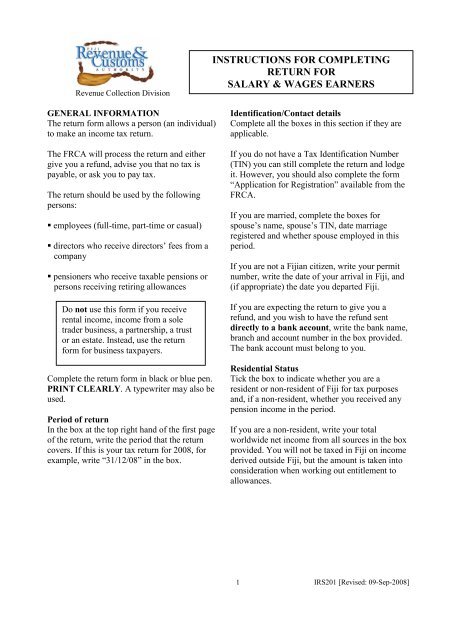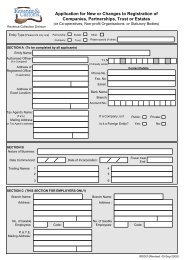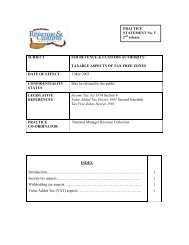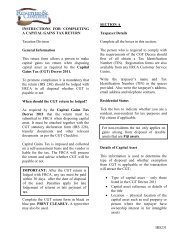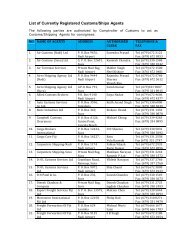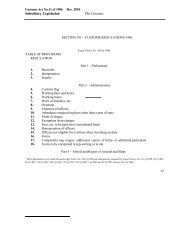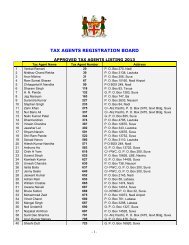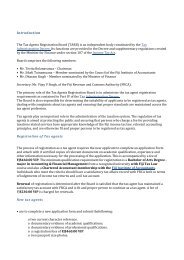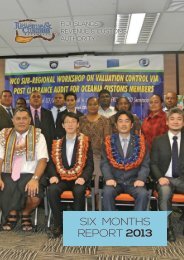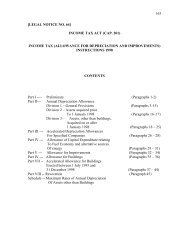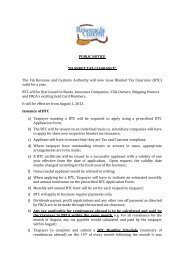I STRUCTIO S FOR COMPLETI G RETUR FOR SALARY & WAGES ...
I STRUCTIO S FOR COMPLETI G RETUR FOR SALARY & WAGES ...
I STRUCTIO S FOR COMPLETI G RETUR FOR SALARY & WAGES ...
You also want an ePaper? Increase the reach of your titles
YUMPU automatically turns print PDFs into web optimized ePapers that Google loves.
Revenue Collection Division<br />
GE�ERAL I�<strong>FOR</strong>MATIO�<br />
The return form allows a person (an individual)<br />
to make an income tax return.<br />
The FRCA will process the return and either<br />
give you a refund, advise you that no tax is<br />
payable, or ask you to pay tax.<br />
The return should be used by the following<br />
persons:<br />
� employees (full-time, part-time or casual)<br />
� directors who receive directors’ fees from a<br />
company<br />
� pensioners who receive taxable pensions or<br />
persons receiving retiring allowances<br />
Do not use this form if you receive<br />
rental income, income from a sole<br />
trader business, a partnership, a trust<br />
or an estate. Instead, use the return<br />
form for business taxpayers.<br />
Complete the return form in black or blue pen.<br />
PRI�T CLEARLY. A typewriter may also be<br />
used.<br />
Period of return<br />
In the box at the top right hand of the first page<br />
of the return, write the period that the return<br />
covers. If this is your tax return for 2008, for<br />
example, write “31/12/08” in the box.<br />
I�<strong>STRUCTIO</strong>�S <strong>FOR</strong> <strong>COMPLETI</strong>�G<br />
<strong>RETUR</strong>� <strong>FOR</strong><br />
<strong>SALARY</strong> & <strong>WAGES</strong> EAR�ERS<br />
Identification/Contact details<br />
Complete all the boxes in this section if they are<br />
applicable.<br />
If you do not have a Tax Identification Number<br />
(TIN) you can still complete the return and lodge<br />
it. However, you should also complete the form<br />
“Application for Registration” available from the<br />
FRCA.<br />
If you are married, complete the boxes for<br />
spouse’s name, spouse’s TIN, date marriage<br />
registered and whether spouse employed in this<br />
period.<br />
If you are not a Fijian citizen, write your permit<br />
number, write the date of your arrival in Fiji, and<br />
(if appropriate) the date you departed Fiji.<br />
If you are expecting the return to give you a<br />
refund, and you wish to have the refund sent<br />
directly to a bank account, write the bank name,<br />
branch and account number in the box provided.<br />
The bank account must belong to you.<br />
Residential Status<br />
Tick the box to indicate whether you are a<br />
resident or non-resident of Fiji for tax purposes<br />
and, if a non-resident, whether you received any<br />
pension income in the period.<br />
If you are a non-resident, write your total<br />
worldwide net income from all sources in the box<br />
provided. You will not be taxed in Fiji on income<br />
derived outside Fiji, but the amount is taken into<br />
consideration when working out entitlement to<br />
allowances.<br />
1<br />
IRS201 [Revised: 09-Sep-2008]
Marital status & dependant details<br />
This information is used to determine your<br />
eligibility for dependent allowances, and whether<br />
you can lodge a joint return.<br />
Only to be completed by persons who<br />
are Fiji residents for tax purposes.<br />
Non-residents can go to next section<br />
on Income Details.<br />
Complete either the “Female Resident” or “Male<br />
Resident” section depending on your gender. In<br />
each section, tick only one box. Determine which<br />
one of the 5 options in each box applies to you<br />
and tick only that box.<br />
I�COME DETAILS<br />
Item 1: Income from employment/pension<br />
Complete all the details:<br />
� Name of employer<br />
� Amount of tax deducted per employee<br />
certificate<br />
� Amount of salary and wages per certificate<br />
Joint return<br />
If this is a joint return lodged by a male resident<br />
taxpayer, include all of your wife’s income here<br />
with any tax deducted.<br />
Item 2: Total value of benefits<br />
Transfer here the amount of benefits shown on<br />
your employee certificate. If you have more than<br />
one certificate, add up the benefits from each<br />
certificate and transfer the total to the return.<br />
Item 3: Director’s fees<br />
Complete all the details:<br />
� Name of paying company<br />
� Amount of tax deducted per certificate<br />
� Amount of director’s fees per certificate<br />
Item 4: Interest Income<br />
Complete all the details:<br />
� Name of financial institution<br />
� Amount of tax deducted per certificate<br />
� Amount of gross interest per certificate<br />
Item 5: Dividend Income<br />
Complete all the details:<br />
� Name of paying company<br />
� Amount of tax deducted per certificate<br />
� Amount of gross dividends per certificate<br />
� Attach dividend certificate issued by the company<br />
Item 6: Other income<br />
Put in this box the total of any other income you<br />
have received which has not been included<br />
elsewhere, such as:<br />
� tips and other gratuities<br />
� withdrawals from cyclone reserve accounts, and<br />
� any other income taxable under the tax laws not<br />
elsewhere specified in this return.<br />
Item 7: Total income<br />
Add up all the income amounts listed above and put<br />
the total at the “Total Income” box.<br />
Item 8: Redundancy Payment<br />
These payments are not included in your total<br />
income, but should be returned here.<br />
Redundancy payments are tax-free up to $15,000,<br />
and subject to a tax rate of 15% on the balance over<br />
$15,000.<br />
2<br />
Staple the original of your employee<br />
certificate(s) to the top right hand<br />
corner of Page 2 of the return.<br />
If you have lost your employee<br />
certificate ask your employer for a<br />
signed letter setting out the details that<br />
were on the certificate, and attach the<br />
letter to the return. In case of duplicate<br />
slips, it must have the Employer’s<br />
stamp.<br />
IRS201 [Revised: 09-Sep-2008]
DEDUCTIO�S, EXEMPTIO�S and<br />
ALLOWA�CES<br />
Item 9: Pension Exemption<br />
Write here the amount of pension income that is<br />
deductible<br />
Item 10: Lump Sum Payment Deduction (max<br />
$5000.00)<br />
If you have received a lump sum payment and are<br />
entitled to a deduction for that income, write the<br />
amount of that deduction in the box.<br />
Item 11: Employee share scheme<br />
If you have received any income under an<br />
employee share scheme, write he amount of that<br />
share in the box.<br />
Item 12: Donations<br />
Write here the amount of tax-deductible donations<br />
you have made to approved organisations/charities.<br />
Attach to your tax return, original receipts as<br />
evidence of donations made.<br />
Item 13: Dividend exemption<br />
If you have returned income from dividends above,<br />
and are entitled to a deduction for that dividend<br />
income, write the amount of that deduction in the<br />
box. Attach to your tax return, original copy of<br />
dividend certificate as evidence.<br />
Item 14: Spouse allowance<br />
If you are a married man (not separated) whose<br />
wife is not working, you may claim $1,200. If your<br />
wife is working, you cannot claim this allowance.<br />
For first claim, attach a certified copy of marriage<br />
certificate. If legally separated during the year,<br />
attach a certified copy of Decree Nisi. For<br />
widow/widower, attach a certified copy of death<br />
certificate of spouse.<br />
If you are a married woman (not separated) you<br />
may claim $1,200 whether your husband is working<br />
or not. If widow or widower claim $1,200.<br />
Item 15: Child allowance<br />
The allowance is for children (natural, step or<br />
legally adopted children) who are under 18 years of<br />
age, or between 18 and 27 years of age if full-time<br />
at school, college/universities or other educational<br />
establishment.<br />
For first claim, attach a certified copy of child’s<br />
Item 15 continued:<br />
certified copy of legal adoption documents. For<br />
child over 18 and under 27, evidence to be<br />
provided if child is a fulltime student at any<br />
tertiary institution.<br />
A maximum of 5 children can be claimed. The<br />
allowance is $500 for the first 2 children and<br />
$300 each for the next 3 children.<br />
Item 16: Elderly Dependent Allowance<br />
A maximum of 2 dependent relative’s age 70<br />
years or more can be claimed. The allowance is<br />
$200 for each dependent. A separate dependent<br />
relative claim form should be completed if you<br />
wish to claim for this allowance. Attach a<br />
certified copy of the birth certificates of elderly<br />
dependents. Complete Declaration Form<br />
(IRS011) for elderly dependents and submit with<br />
your tax return.<br />
Item 17: Life insurance<br />
The allowance is in respect of the following:<br />
� life insurance premiums payable by a married<br />
man in respect of himself, his wife or child<br />
� life insurance premiums payable by a married<br />
woman in respect of herself.<br />
� Attach original copy of Statement of Insurance<br />
Premiums paid to your Insurer during the year.<br />
Superannuation<br />
The allowance is in respect of the following:<br />
� contributions to the Fiji National Provident<br />
Fund (FNPF)<br />
� contributions to an approved pension scheme<br />
� contributions to the Government Widows and<br />
Orphans Pension scheme.<br />
The maximum allowance claimable for both life<br />
insurance and superannuation is $1,500<br />
3<br />
If your employer has deducted F�PF<br />
contributions from your wages, the<br />
amount deducted should be shown on<br />
your employee certificate(s). Transfer<br />
that amount to the return, up to the<br />
maximum claimable of $1500.<br />
IRS201 [Revised: 09-Sep-2008]
irth certificate. For adopted child, attach a<br />
4<br />
IRS201 [Revised: 09-Sep-2008]
Calculation of refundable/payable<br />
Write the total of all deductions, exemptions and<br />
allowances in the box provided.<br />
Deduct that total from the amount of total income.<br />
The difference will be your total chargeable<br />
income.<br />
The tax payable on your chargeable income<br />
depends on whether or not you are a resident of Fiji<br />
for tax purposes.<br />
Calculate the tax payable on your chargeable<br />
income (see table below).<br />
You will receive a credit for any tax paid in<br />
advance (eg for tax deducted from wages under the<br />
PAYE system).<br />
Deduct any tax paid in advance from the amount of<br />
tax payable on your chargeable income.<br />
If the tax paid in advance exceeds the tax payable<br />
on your chargeable income, the difference will be<br />
refunded to you.<br />
If the tax paid in advance is less than the tax<br />
payable on your chargeable income, you must pay<br />
the difference within 30 days of receiving your<br />
notice of assessment.<br />
2008 RESIDE�T TAX RATES<br />
(For other years’ rates contact the FRCA)<br />
Year of Income 2008(1 st Jan to 31 st May,2008)<br />
Income ($) Resident<br />
0 – 9,000 Nil<br />
9,001-10,000 15% of excess over $9,000<br />
10,001-20,000 150 +25% of excess over 10,000<br />
20,001 + 2,650+31% of excess over $20,000<br />
Year of Income 2008(1 st Jun to 31 st Dec,2008)<br />
Income ($) Resident<br />
0 – 15,000 Nil<br />
15,001-15,600 25% of excess over $15,000<br />
15,601-22,000 150 +31% of excess over 15,600<br />
22,001 + 2,650+31% of excess over $22,000<br />
2008 �O�-RESIDE�T TAX RATES<br />
(For other years’ rates contact the FRCA)<br />
Income ($) �on-Resident<br />
0 – 9,000 20% of excess over $0<br />
9,001-10,000 $1,800+25% of excess over $9,000<br />
10,001-20,000 $2,050+30% of excess over 10,000<br />
20,001 + $5,050+31% of excess over $20,000<br />
Declaration<br />
Write your name, sign and date the return.<br />
If the return will result in a refund, and you wish to<br />
transfer all or part of that refund to offset your<br />
spouse’s liability, tick the box.<br />
If a tax agent prepares the return, the agent should<br />
complete the “Declaration by Tax Agent” section.<br />
�ote: The income tax law provides severe penalties<br />
for persons who make false returns.<br />
What to do with the completed form<br />
You may either post the form to FRCA or bring it<br />
to any of the FRCA offices listed below.<br />
If posting the form send it (with a cheque for<br />
payment of any tax) to:<br />
For Central & Eastern Division businesses:<br />
Commissioner of Inland Revenue<br />
Private Mail Bag<br />
Suva<br />
For Western Division businesses:<br />
Commissioner of Inland Revenue<br />
Private Mail Bag<br />
Lautoka<br />
For Northern Division businesses:<br />
Commissioner of Inland Revenue<br />
Private Mail Bag<br />
Labasa<br />
If bringing the form to FRCA office, take it to the<br />
office nearest you at the following addresses:<br />
5<br />
IRS201 [Revised: 09-Sep-2008]
For Central & Eastern Division businesses:<br />
Revenue & Customs Services Complex<br />
Corner of Ratu Sukuna Road & Queen Elizabeth Drive<br />
Nasese<br />
For Western Division businesses:<br />
Revenue House<br />
19 Tavewa Avenue<br />
Lautoka<br />
For Northern Division businesses:<br />
1 st Floor Rupan Building<br />
Corner of Nanuku & Jaduram Street<br />
Labasa<br />
If bringing the form to FRCA office, a FRCA<br />
officer will check it and advise if you have missed<br />
out any details. If you need help filling in the form<br />
ask the FRCA officer at the counter.<br />
6<br />
IRS201 [Revised: 09-Sep-2008]


